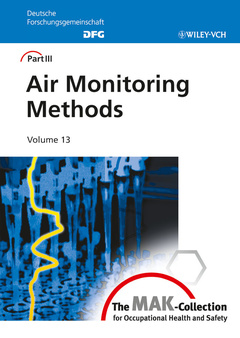Description
The MAK-collection for occupational health and safety: part III: Air monitoring methods, volume 13, Volume 13
The MAK–Collection for Occupational Health and Safety, Part III: Air Monitoring Methods (DFG) Series
Coordinators: Hartwig Andrea, Parlar Harun, Brock Thomas H.
Language: English
Subject for The MAK-collection for occupational health and safety...:
Keywords
Protocols, air monitoring methods, occupational toxicants, environmental monitoring, quality assurance standards, sampling, detection limit, calibration procedures, QA standards, Analytical Laboratories, Toxicologists, Industrial Medicine, GLP compliant, environmental toxicants, diesel engine emissions, nitrous oxide, Commission for the Investigation of Health Hazards of Chemical Compounds in the Work Area, MAK values, maximum workplace concentrations, Deutsche Forschungsgemeinschaft, DFG, Harun
200 p. · 17.5x24.4 cm · Hardback
Description
/li>Contents
/li>Biography
/li>
Quality assurance at workplace measurements
ANALYTICAL METHODS
Beryllium (BGI 505-13-02)
Bisphenol A (BGI 505-75-01)
Carbon tetrachloride, Method No. 2
Carboxylic acid amides (BGI 505-74-01)
Formic acid methyl ester, Method No. 1
Glycol ethers and glycol esters (BGI 505-76-01)
Lead and its inorganic compounds (BGI 505-73-01)
Metals (chromium, copper and inorganic compounds), Method No. 1
Nickel (BGI 505-10-02)
2-Nitronaphthalene (BGI 505-22-02)
Wood dust (BGI 505-41-02)
APPENDIX
Contents of Volumes 1-13 in alphabetical order
Contents of Volumes 1-13 ordered by CAS numbers



